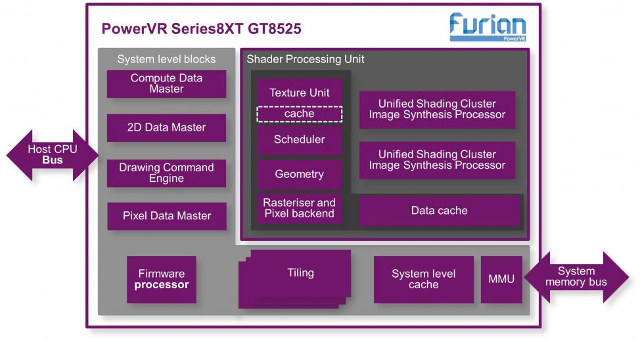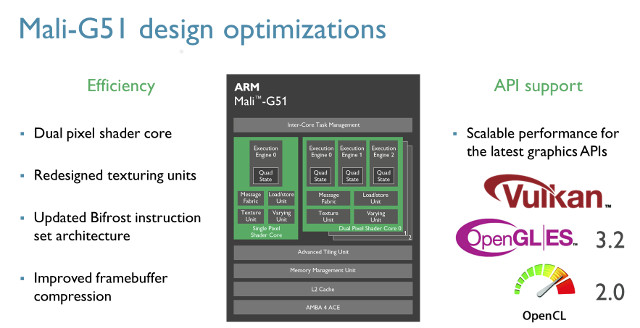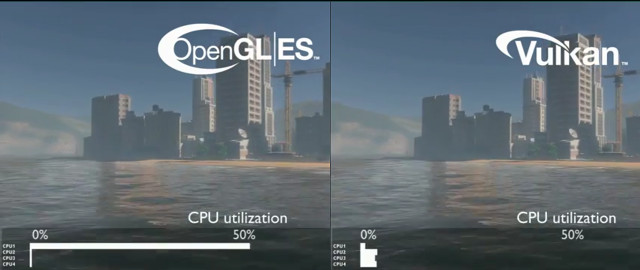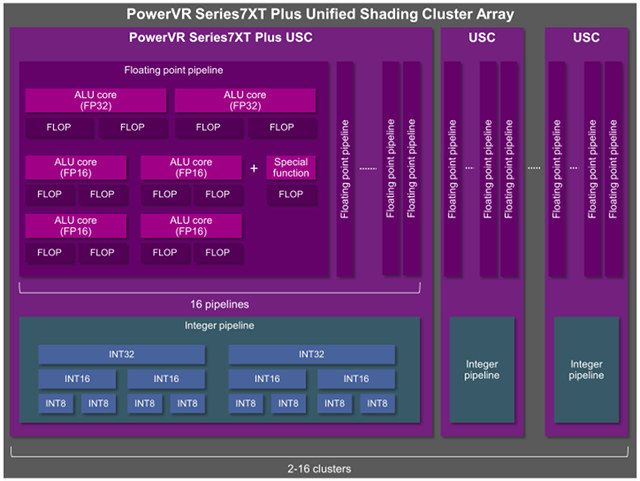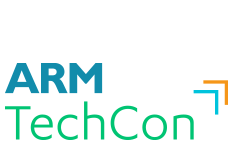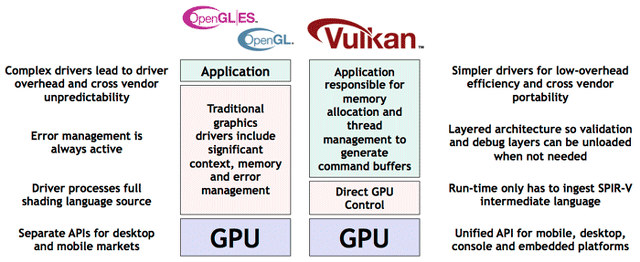Qualcomm Snapdragon 845 processor was expected since May 2017 with four custom Cortex A75 cores, four Cortex A53 cores, Adreno 630 GPU, and X20 LTE modem. with the launch planned for Q1 2018. At least, that what the leaks said. Qualcomm has now formally launched Snapdragon 845 Mobile Platform and rumors were mostly right, as the the octa-core processor comes with four Kryo 385 Gold cores (custom Cortex A75), four Kryo 385 Silver cores (custom Cortex A55) leveraging DynamIQ technology, an Adreno 630 “Visual Processing System”, and Snapdragon X20 modem supporting LTE Cat18/13. The processor is said to use more advanced artificial intelligence (AI) allowing what the company calls “extended reality (XR)” applications, and will soon be found in flagship smartphones, XR headsets, mobile PCs, and more. Qualcomm Snapdragon 845 (SDM845) specifications: Processor 4x Kryo 385 Gold performance cores @ up to 2.80 GHz (custom ARM Cortex A75 cores) 4x […]
Imagination PowerVR “Furian” Series8XT GT8525 GPU Targets High-end Smartphones, Virtual Reality and Automotive Products
Imagination Technologies has unveiled their first GPU based on PowerVR Furian architecture with Series8XT GT8525 GPU equipped with two clusters and designed for SoCs going to into products such as high-end smartphones and tablets, mid-range dedicated VR and AR devices, and mid- to high-end automotive infotainment and ADAS systems. The Furian architecture is said to allow for improvements in performance density, GPU efficiency, and system efficiency, features a new 32-wide ALU cluster design, and can be manufactured using sub-14nm (e.g. 7nm process once available). PowerVR GT8525 GPU supports compute APIs such as OpenCL 2.0, Vulkan 1.0 and OpenVX 1.1. Compared to the previous Series7XT GPU family, Series8XT GT8525 GPU delivers 80% higher fps in Trex benchmark, an extra 50% fps in GFXbench Manhattan benchmark, 50% higher fps in Antutu, doubles the fillrate throughput for GUI, and increases GFLOPs for compute applications by over 50%. GT8525 GPU is available for licensing […]
ARM Introduces Bifrost Mali-G51 GPU, and Mali-V61 4K H.265 & VP9 Video Processing Unit
Back in May of this year, ARM unveiled Mali-G71 GPU for premium devices, and the first GPU of the company based on Bifrost architecture. The company has now introduced the second Bifrost GPU with Mali-G51 targeting augmented & virtual reality and higher resolution screens to be found in mainstream devices in 2018, as well as Mali-V61 VPU with 4K H.265 & VP9 video decode and encode capabilities, previously unknown under the codename “Egil“. Mali-G51 GPU ARM Mali-G51 will be 60% more energy efficiency, and have 60% more performance density compared to Mali-T830 GPU, making the new GPU the most efficient ARM GPU to date. It will also be 30% smaller, and support 1080p to 4K displays. Under the hood, Mali-G51 include an updated Bifrost’s low level instruction set, a dual-pixel shader core per GPU core to deliver twice the texel and pixel rates, features the latest ARM Frame Buffer Compression […]
This Video Shows Vulkan API’s Higher Power Efficiency Compared to OpenGL ES API on ARM SoCs
Vulkan was introduced as the successor of OpenGL ES in March 2015, promising to take less CPU resources, and support multiple command buffers that can be created in parallel and distributed over several cores, at the cost of slightly more complex application programming since less software work in done inside the GPU drivers themselves with app developers needing to handle memory allocation and thread management. This was just a standard at the time, so it still needed some time to implement Vulkan, and work is still in program but ARM showcased the power efficiency of Vulkan over OpenGL ES in the video embedded at the end of this post. The demo has the same graphics details and performance using both OpenGL ES and Vulkan, but since the load on the CPU in that demo can be distributed over several CPU cores with Vulkan against a single core for OpenGL ES, […]
PowerVR GT7200 Plus and GT7400 Plus GPUs Support OpenCL 2.0, Better Computer Vision Features
Imagination Technologies introduced PowerVR Series7XT GPU family with up to 512 cores at the end of 2014, and at CES 2016, they’ve announced Series7XT Plus family with GT7200 Plus and GT7400 Plus GPUs, with many of the same features of Series7XT family, plus the addition of OpenCL 2.0 API support, and improvements for computer vision with a new Image Processing Data Master, and support for 8-bit and 16-bit integer data paths, instead of just 32-bit in the previous generation, for example leading to up to 4 times more performance for applications, e.g. deep learning, leveraging OpenVX computer vision API. GT7200 Plus GPU features 64 ALU cores in two clusters, and GT7400 Plus 128 ALU cores in a quad-cluster configuration. Beside OpenCL2.0, and improvements for computer vision, they still support OpenGL ES 3.2, Vulkan, hardware virtualization, advanced security, and more. The company has also made some microarchitectural enhancements to improve performance […]
ARM TechCon 2015 Schedule – IoT, Servers, 64-bit ARM, Power Usage Optimization, and More
The ARM Technology Conference (ARM TechCon) will take place on November 10 – 12, 2015, in Santa Clara Convention Center, and just like every year, there will be a free exposition for companies to showcase their latest innovation and/or products, as well as a technical conference with sessions and workshops sorted into various tracks: Automotive/Embedded Vision Embedded IoT Mobile/Connectivity Networking Infrastructure/Servers Tools & Implementation Wearables/Sensors ARM Training Day Sponsored Vendor Training Special Event General Event Software Developers Workshop You can find the complete schedule on ARM TechCon website. Although I won’t attend, I’ve created my own virtual schedule with some of the sessions I found interesting. Tuesday – November 10 8:30 – 9:20 – ARM Vision for Thermal Management and Energy Aware Scheduling on Linux by Ian Rickards (ARM), Charles Garcia-Tobin (ARM), Bobby Batacharia (ARM) This talk will cover the history and where are we going, for ARM’s Power Software (IPA, […]
Google Plans Vulkan API Support for Android, Imagination Shows a Demo
Vulkan graphics API is the successors to OpenGL and OpenGL ES API, which will support multi-threaded rendering, move some of the complexity to the applications, and simplify graphics drivers, which may not be a bad things since these tend to be closed source, and bugs may be hard to get fixed. Google, which is now a subsidiary of a new company called Alphabet, has recently announced that Vulkan will be implemented in future versions of Android, although OpenGL ES will still be supported, so developers can select their preferred graphics API for their apps, as Vulkan will be more complex for application programmers than OpenGL ES. Separately, Imagination technologies showcased their Vulkan driver for PowerVR Rogue GPU on the Nexus Player powered by an Intel SoC including a PowerVR G6430 GPU, and compare the Vulkan demo to the same demo using OpenGL ES 3.0 drivers. The difference between Vulkan and OpenGL […]
Meet Vulkan, The Successor of OpenGL and OpenGL ES 3D Graphics APIs
So far embedded systems are typically using SoCs with GPU supporting OpenGL ES, a subset of the full fledge OpenGL API used in desktop computers and workstations. These royalty-free standards are defined by Khronos Group non-profit organization, and as features in the embedded space and traditional computers merge, the group has now revealed the next-generation OpenGL specs will be called Vulkan. The new API will run on GPUs supporting OpenGL ES 3.1 or greater, take less CPU resources than its predecessors, and support multiple command buffers that can be created in parallel. More work will be required at the application level, but direct GPU control by the drivers will apparently result in less memory copies improving performance, or at least off-loading the CPU. It might be transparent to developers using game engines. GPU drivers will also be less complex. Vulkan will also use the new SPIR-V language shared with OpenCL […]



